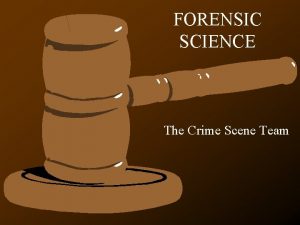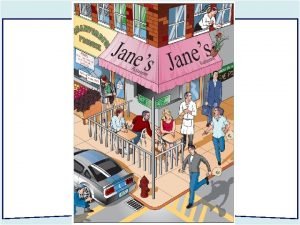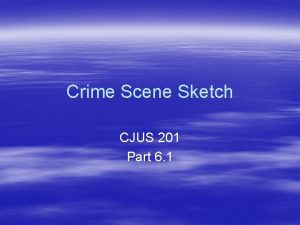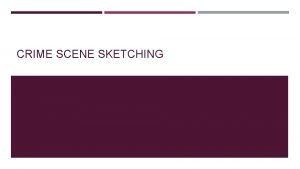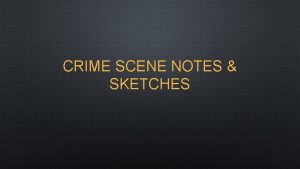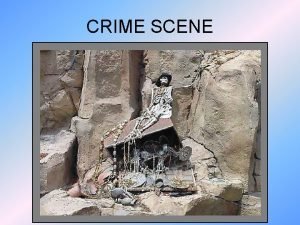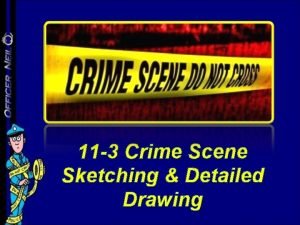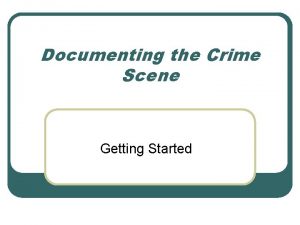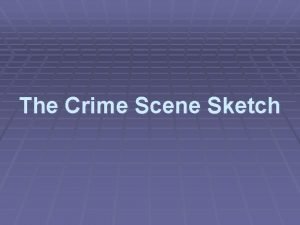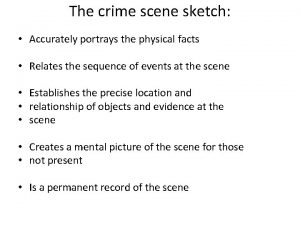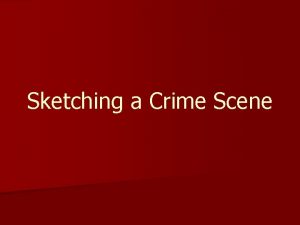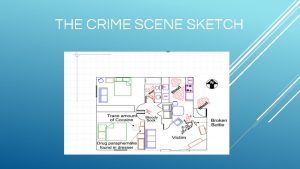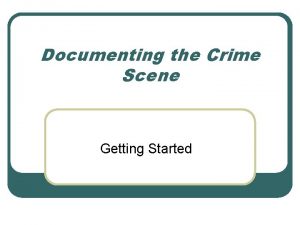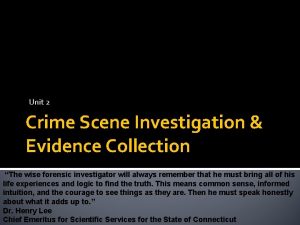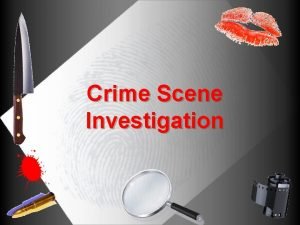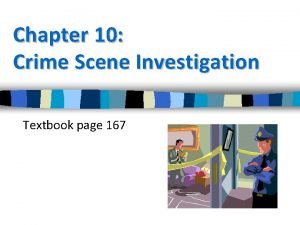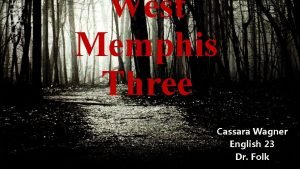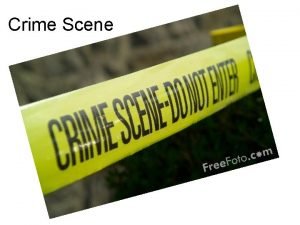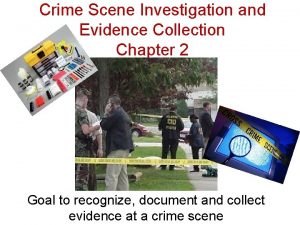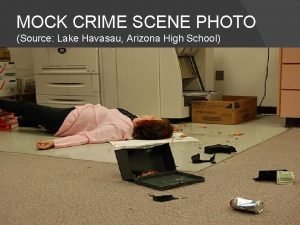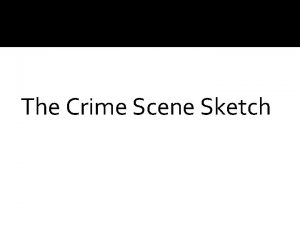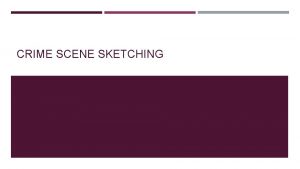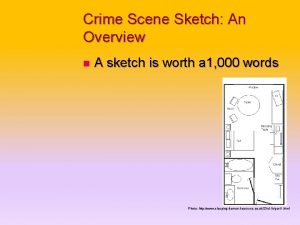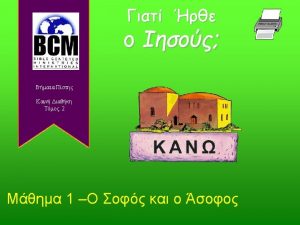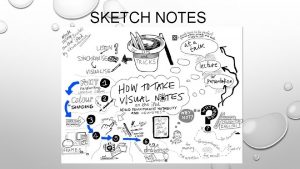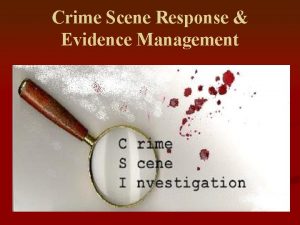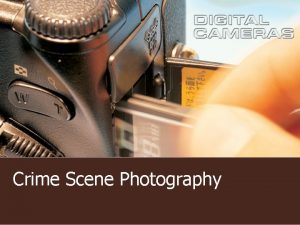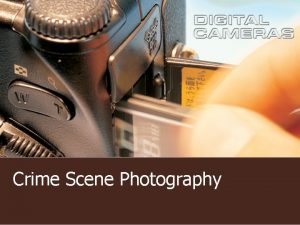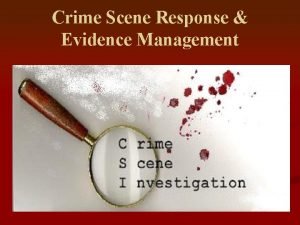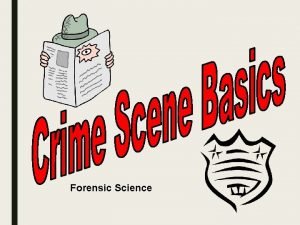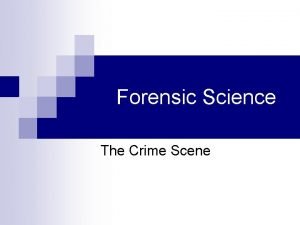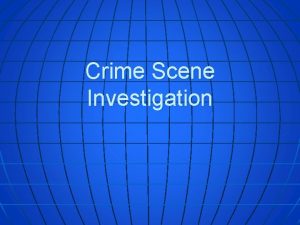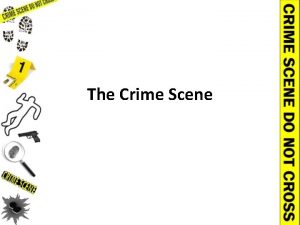The Crime Scene Sketch The Crime Scene Sketch























- Slides: 23

The Crime Scene Sketch

The Crime Scene Sketch Introduction § The crime scene sketch: § Accurately portrays the physical facts § Relates the sequence of events at the scene § Establishes the precise location and relationship of objects and evidence at the scene § Creates a mental picture of the scene for those not present § Is a permanent record of the scene

The Crime Scene Sketch Overview § A crime scene sketch assists in: 1) Interviewing and interrogating persons 2) Preparing an investigative report 3) Presenting the case in court § The sketch supplements photographs, notes, plaster casts and other investigative techniques. § Two types of sketches § Rough sketch § Finished or scale sketch

The Crime Scene Sketch The Rough Sketch § The rough sketch is the first pencil-drawn outline of the scene and the location of objects and evidence within this outline. § Usually not drawn to scale § Although distances are measured and indicated in the sketch § Sketch after photographs are taken and before anything is moved. § Sketch as much as possible.

The Crime Scene Sketching Materials § Paper § Pencil § Measuring tape § Ruler § Clipboard § Eraser § Compass

The Crime Scene Sketch Steps in Sketching the Crime Scene § Observe and plan § Measure distances § Outline the area § Locate objects and evidence within the outline § Record details § Make notes § Identify the sketch with a legend a scale

The Crime Scene Sketch Measure and Outline Area § A steel tape is best § It doesn’t stretch § Use conventional units of measurement § Inches § Feet § Centimeters § Meters

The Crime Scene Sketch Measure and Outline Area § North should be at the top of the paper. § Determine Scale § Take the longest measurement at the scene and divide it by the longest measurement of the paper used for sketching. ½”= 1’small rooms ¼”= 1’large (LG) rooms 1/8”= 1’very LG rooms ½”= 10’ LG buildings 1/8”= 10’large land area

The Crime Scene Sketch Measure and Outline Area § Measure from fixed locations ü Walls ü Trees ü Telephone poles ü Corners ü Curbs ü Outlets ü Any Immovable Object

The Crime Scene Sketch Plot Objects and Evidence § Plotting methods are used to locate objects and evidence on the sketch. § They include the use of: üRectangular coordinates üA baseline üTriangulation üCompass points.

The Crime Scene Sketch Rectangular Coordinates Uses two adjacent walls as fixed points as distances are measured at right angles

The Crime Scene Sketch Baseline Method § Run a baseline from one fixed point to another, from which measurements are taken at right angles.

The Crime Scene Sketch Triangulation § Common in outdoor scenes § Uses straight-line measurements from two fixed objects to the evidence to create a triangle with evidence in the angle formed by two straight lines.

The Crime Scene Sketch Compass Point Method § Uses a protractor to measure the angle formed by two lines

The Crime Scene Sketch Cross-Projection Method § Presents floors and walls as they were on one surface.

The Crime Scene Sketch The Legend § Contains: § Case number § Type of crime § Investigator § Persons assisting § Direction of North § Identifying information in sketch -Key § Scale

The Crime Scene Sketch

The Crime Scene Sketch § Auto Accident Reconstruction

The Crime Scene Sketch Other Sketch Features

The Crime Scene Sketch Other Sketch Features

The Crime Scene Sketch Other Sketch Features

The Crime Scene Sketch Other Sketch Features

The Crime Scene Sketch More Advanced Sketch Program Features
 Deductive reasoning crime scene investigation
Deductive reasoning crime scene investigation Final sketch crime scene
Final sketch crime scene Cross projection sketch crime scene
Cross projection sketch crime scene Cross-projection sketch
Cross-projection sketch Crime scene notes
Crime scene notes Finish sketch crime scene
Finish sketch crime scene Corpus delicti
Corpus delicti How to draw a crime scene sketch
How to draw a crime scene sketch Sketch all serious crime and crash scenes:
Sketch all serious crime and crash scenes: Crime scene sketch
Crime scene sketch A crime scene sketch should include
A crime scene sketch should include Sketching a crime scene
Sketching a crime scene Scene sketch
Scene sketch Sketch all serious crime and crash scenes:
Sketch all serious crime and crash scenes: Seven s's of crime scene investigation description
Seven s's of crime scene investigation description Tcole 2106
Tcole 2106 Line/strip search pattern
Line/strip search pattern Csi search patterns
Csi search patterns Robin hood hills crime scene photos
Robin hood hills crime scene photos _____ is done with the first responding officer.
_____ is done with the first responding officer. While the csi team is searching the crime scene, _____.
While the csi team is searching the crime scene, _____. Mock crime scene scenarios
Mock crime scene scenarios The seven s's of crime scene investigation definition
The seven s's of crime scene investigation definition Profiling serial killers
Profiling serial killers
